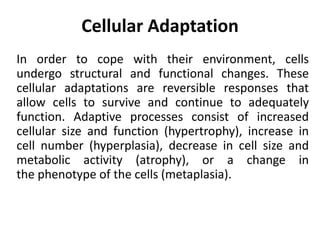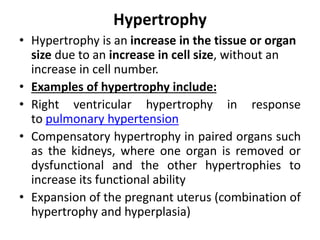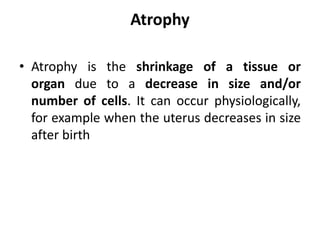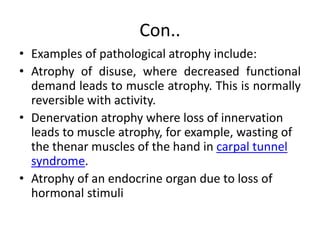Cellular Adaptation.pptx for the purpose of BSN
- 1. Cellular Adaptation In order to cope with their environment, cells undergo structural and functional changes. These cellular adaptations are reversible responses that allow cells to survive and continue to adequately function. Adaptive processes consist of increased cellular size and function (hypertrophy), increase in cell number (hyperplasia), decrease in cell size and metabolic activity (atrophy), or a change in the phenotype of the cells (metaplasia).
- 2. Con… • Allows cell survival and continued cellular function in an altered steady state • Results from: – Increased demand – Changes in vascular supply, nutrients, or stimulation – Chronic irritation
- 4. Hyperplasia • Hyperplasia is an increase in the tissue or organ size due to increased cell number, without an increase in cell size. • Examples of hyperplasia include: • Endometrial proliferation under the influence of oestrogen during the menstrual cycle • Thyroid goitre in response to iodine deficiency • Epidermal thickening in eczema
- 5. Hypertrophy • Hypertrophy is an increase in the tissue or organ size due to an increase in cell size, without an increase in cell number. • Examples of hypertrophy include: • Right ventricular hypertrophy in response to pulmonary hypertension • Compensatory hypertrophy in paired organs such as the kidneys, where one organ is removed or dysfunctional and the other hypertrophies to increase its functional ability • Expansion of the pregnant uterus (combination of hypertrophy and hyperplasia)
- 6. Atrophy • Atrophy is the shrinkage of a tissue or organ due to a decrease in size and/or number of cells. It can occur physiologically, for example when the uterus decreases in size after birth
- 7. Con.. • Examples of pathological atrophy include: • Atrophy of disuse, where decreased functional demand leads to muscle atrophy. This is normally reversible with activity. • Denervation atrophy where loss of innervation leads to muscle atrophy, for example, wasting of the thenar muscles of the hand in carpal tunnel syndrome. • Atrophy of an endocrine organ due to loss of hormonal stimuli
- 8. Metaplasia • Metaplasia is the reversible change of one differentiated cell type to another. • Examples of metaplasia include: • Bronchial pseudostratified ciliated epithelium becoming stratified squamous epithelium in response to cigarette smoke. • Stratified squamous epithelium in the oesophagus becoming gastric epithelium when exposed to persistent acid reflux (Barrett’s oesophagus)









